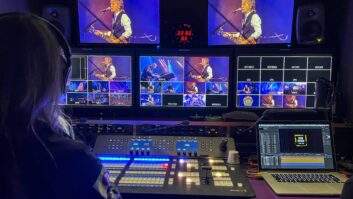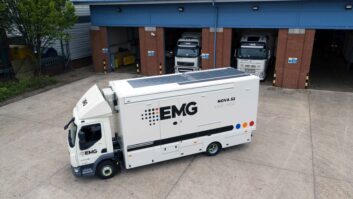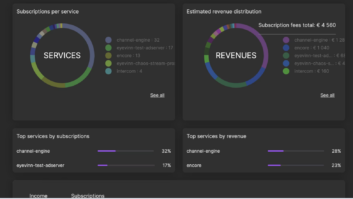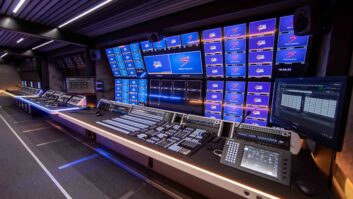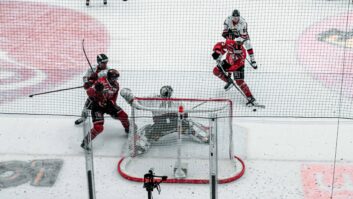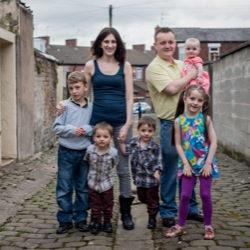
Twofour’s Happy Families production for ITV is a new four-part fly-on-the-wall series that is claimed to have broken new ground in observational documentaries by filming everything with remote cameras using a sophisticated rig that was installed and de-rigged in just four days.
The equipment had to be mobile enough to easily move around the country, so that it could be used to shoot for seven days in each of four consecutive locations.
Each shoot involved tight working spaces in typical urban households. Crews had limited installation times, while the need for discreet camera work and the requirement to shoot in multiple rooms dictated the type and amount of production equipment that could be used.
This type of fly-on-the-wall filming has been done before, but has evolved since the days of such programmes as The Family (the 1974 BBC series made by producer Paul Watson, and directed by Franc Roddam, which has often been cited as the beginning of reality television).
For Happy Families, far more locations have been used in short succession, while the producers wanted to avoid interfering with families’ daily activities (something that is impossible if a camera crew is following around everywhere). This meant adopting a new approach. There could be no ENG camcorders, no trailing wires and no turning of a bedroom into a production suite.
“To my knowledge this is a unique production as we had four different locations to film within three months. I don’t know of another show that has tackled so many locations in such a short time with 20-plus cameras,” says Nick McLachlan, MD of Minicams, which was contracted to fulfil the installation in all the houses.
At each location, his crew installed Panasonic PTZ cameras that McLachlan says “are high quality, reliable and can be controlled manually and with pre-sets. With only four days to rig each venue, they were ideal.”
A diversity radio microphone set up was chosen to match the available radio spectrum at each site, and was coupled with a multipoint active antenna system to provide optimum RF coverage. The sound and picture feeds were fed through into a neighbouring property or Portakabin where Minicams set up a Mini-Rig portable production unit and gallery.
The Mini-Rig has been designed by Minicams to be rapidly installed. It can take in multiple HD video streams and audio channels, and is claimed to be simple to control via a fully customisable graphical user interface and touchscreen control panel (following Happy Families, the rig’s first major outing, the GUI has been developed further to make PPU control even slicker).
“There were two main challenges to address. With a small crew at the production desk, it can be very difficult to manage so many cameras. And secondly, co-ordinating the audio with the live video feed is difficult when there are so many microphones in multiple locations,” explains McLachlan.
To solve this, Minicams wrote new control software that could activate cameras by group and enable the audio to follow that particular set of cameras. Up to 64 microphones with remote-able pre-amps are routed into the MADI-connected system; 32 microphones can be assigned to the control surface at any one time, allowing the production team to monitor individual inputs, mix sources and record broadcast-quality sound.
McLachlan wanted to make it so intuitive that the hothead operator can manage all 24 cameras, so a single button-push switches both vision and camera control simultaneously to the selected camera. The operator can also select the appropriate 8-channel audio feed by either audio-follows-video or by manually selecting sources.
“Home life can be chaotic. There were no rules for the families, no restrictions on their movement, so the system had to be versatile, quick and accurate. With our system, the operator can move fast and follow the action from room to room,” he adds.
Each episode interweaves stories from the various family members. “It feels like a national conversation when the families are talking about issues that affect them,” says David Clews, Twofour’s head of documentaries. “We hope people watching it will feel that the show could be about them. We’ll be around the dining room table of each of our families as they confront their latest dilemmas.”
Remote cameras
The variable speed of the pan, tilt and zoom mechanisms of the Panasonic AW-HE50S and AW-HE120 cameras, under the control of a Panasonic AW-RP50 remote camera controller, meant that house members could be tracked throughout the house. Twofour previously used 64 AW-HE50 cameras on another reality series (Educating Yorkshire for Channel 4), which was a seven-week shoot at a school.
For Minicams, it was important that, despite having so much equipment rigged in the house, the technology should be discreet — not just so that the viewers wouldn’t see it, but to put the families at ease. “We had to be responsive to the situation. We have an in-house carpentry team that can disguise – or at least minimise – the impact of the kit. We also developed a single core system for the power, SDI and Ethernet cabling to keep visible wiring to an absolute minimum,” says McLachlan.
Video feeds were brought into a For-A HVS-390HS 2M/E vision mixer designed for live production, which was selected for its high quality, flexibility and small size.
The PPU, vision mixer and PTZ control surface were housed in an adjoining premises, along with: an OmniTek OTR 1001 video and audio analysis unit; CTP intercom/talkback panel; Blackmagic Videohub Smart Control panel; Evertz timecode generator; and a Dotec MADI interface.
Despite all this technology, everything (PPU, cameras and audio packed into a compact, portable kit) can be run off domestic power, with no need for a supplementary generator or commercial electrical supply, even for the air conditioning equipment or ingest. The live feeds from the PPU were broadcast ready and optimised for ingest by Twofour. Each of the four streams of HD video with eight channels of embedded audio were routed into recording racks powered by the simply uprated domestic house supply.
“Our experience in fast-turnaround TV and understanding of the editorial demands of TV production have been vital in developing the PPU. Mini-Rig can be installed quickly in any space very fast and with little notice,” says McLachlan.
By David Fox
Photo: ITV

